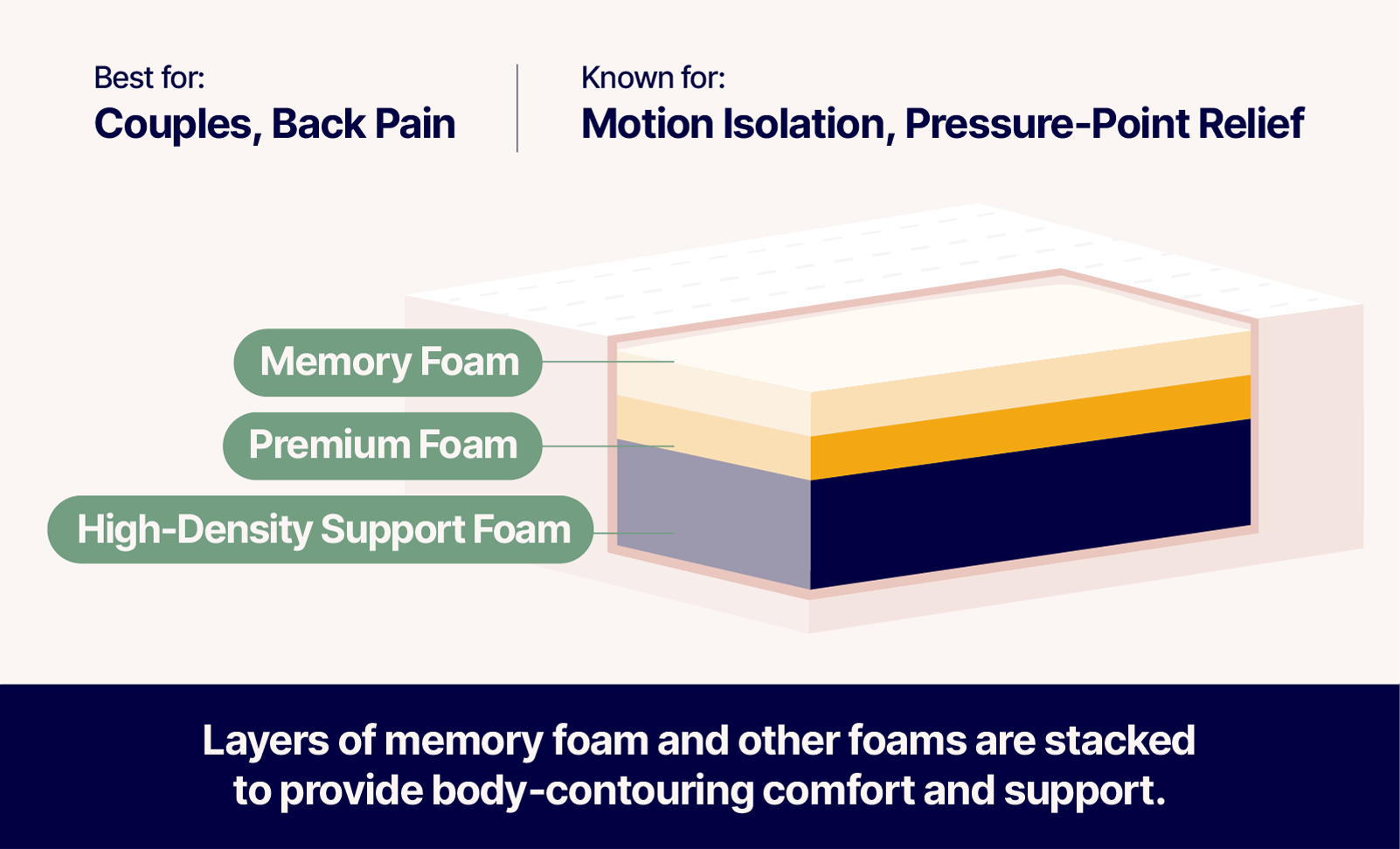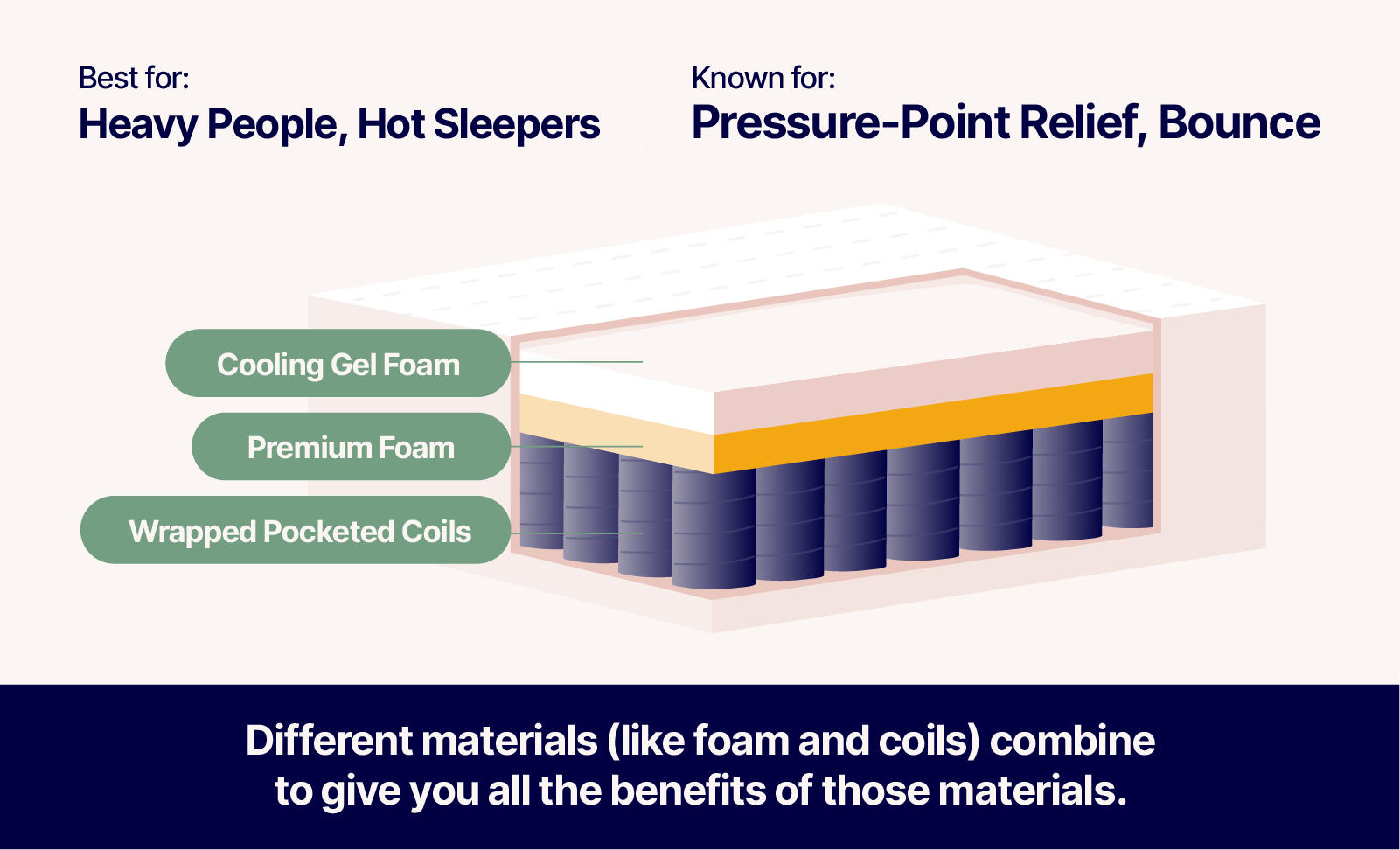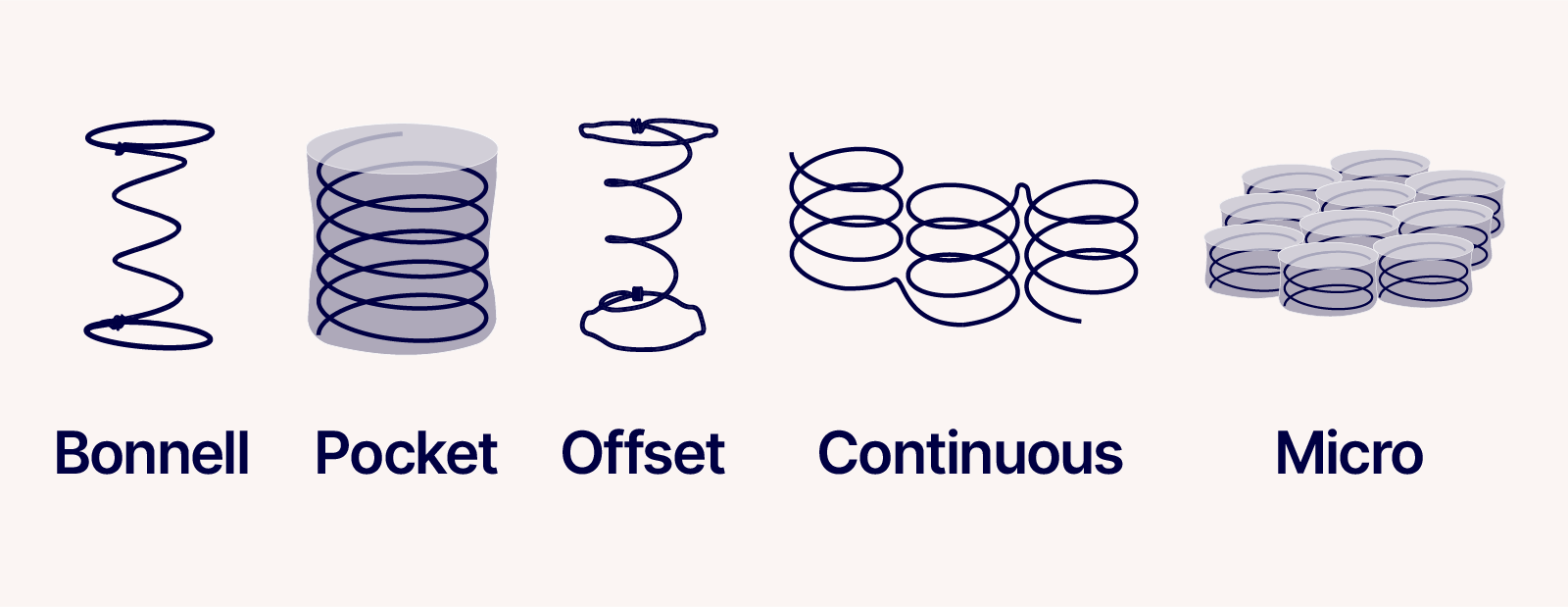Hybrid Mattress vs Memory Foam: Which Mattress Is Best For You? (2025)
Updated: March 31, 2025 | Published: July 31, 2024Choosing between a hybrid mattress and a memory foam mattress can be a challenging decision. Memory foam mattresses have excellent pressure-point relief and motion isolation. Hybrid mattresses, on the other hand, combine the best of foam and innerspring mattresses to create a balance between support and comfort.
This article will explore memory foam and hybrid mattresses, comparing their construction, benefits, and drawbacks. After reading this article, you’ll be better equipped to decode which mattress type best suits your needs.
Breakdown: Hybrid vs Memory Foam Mattress
| Category | Hybrid Mattresses | Memory Foam Mattresses |
|---|---|---|
Cost | $1,000–3,000+ | $500–2,000+ |
Feel | Balanced feel with bounce and responsiveness | Contours around your body for a “hugging” effect |
Advantages | Good balance between support, bounce, and breathability
| Excellent motion isolation and pressure-point relief
|
Disadvantages | Can be heavier than foam mattresses, especially with larger mattress sizes
| Not ideal for heavier sleepers
|
Best for… | Sleepers who prefer bounce and support
| Light sleepers
|
READ MORE: Which mattress type is right for you?
Memory Foam Mattresses
Also known as viscoelastic foam, memory foam was developed by NASA in the 1960s for use in airplane seats. Most memory foam mattresses contain three or more layers of foam, and each layer may be made from a different type of memory foam.
While many brands use the terms “foam” and “memory foam” interchangeably, not all foam used in mattresses is memory foam. Memory foam is a specific type of polyurethane foam that’s known for its viscoelastic properties, meaning it’s dense and slow to respond.
In contrast, many mattresses use general polyurethane foam, which is less dense and responds more quickly to pressure.

READ MORE: Foam vs hybrid mattresses: which should you choose?
Memory foam adapts to pressure and heat, contouring itself to your body as you’re lying down. This is great if you’re looking for pressure-point relief.
In addition, higher-quality memory foam mattresses often come with foam layers tailored to your specific needs. Octave Vista, for instance, features copper-infused cooling memory foam in the comfort layer to help pull excess heat away from the body so you can enjoy a fully restorative sleep.
Cooling technologies are becoming more and more common in memory foam mattresses. This is because memory foam tends to trap heat, especially memory foam with a closed-cell structure. Open-cell memory foam is more breathable, and doesn’t trap heat as much.
READ MORE: Get our ranked list of the best memory foam mattresses
Memory Foam Mattress Pros & Cons
| Pros | Cons |
|---|---|
|
|
Hybrid Mattresses
Hybrid mattresses combine the best of both foam mattresses and innerspring mattresses, offering a balanced sleep experience. Hybrid mattresses like Logan & Cove Choice typically use at least one foam layer that’s at least 2″ thick, paired with different types of coils. The coil layers in a hybrid mattress are typically 6″–10″ in height.

In addition to different foam varieties, hybrid mattresses may use different kinds of coils in their construction (sometimes more than one). You’ll usually find these coil types in a hybrid mattress:
- Continuous coils are connected to each other at their tops and bottoms to provide support. These springs are long-lasting but known to be noisy.
- Bonnell coils have an hourglass shape and are often wired together for added strength. They’re durable but less supportive than other coil types, and they don’t isolate motion very well.
- Offset coils are similar to Bonnell coils, but the top and bottom sections of each coil are squared off. This gives them better motion isolation and support.
- Pocket coils are individually wrapped in fabric and aren’t linked with each other. This makes them much quieter, more durable, more responsive, and better at isolating motion than other coil types.
- Micro coils have the same basic design as pocket coils, but they’re much smaller. Often found with larger pocket coils in a separate layer, micro coils help the mattress contour to your body.

Hybrid Mattress Pros & Cons
| Pros | Cons |
|---|---|
|
|
Should you choose a memory foam mattress vs hybrid mattress?
Both memory foam and hybrid mattresses can provide comfortable sleep, no matter what budget you’re working with.
Consider a memory foam mattress like Octave Vista if you want a mattress with excellent pressure-point relief and motion isolation for an undisturbed night’s sleep. If you sleep hot, look for one with advanced cooling features, like Vista’s copper-infused foam and cooling nanofibre cover that pulls away sweat and heat from your body.
Think about getting a hybrid if you want a balance between comfort and support. Hybrids like Logan & Cove Choice offer the best of both worlds, and tend to work well with most sleep preferences.
READ MORE: Check out our guide on buying a mattress online vs in-store
Our goal is to provide the information you need to find the mattress that’s right for you. Get started with some of our most popular mattress shopping resources:
- Best Mattress Guides: Best Mattress Canada, Best Mattress In a Box
- Reviews: Douglas Original, Logan & Cove Choice, Juno, Octave Vista
- Comparisons: Douglas vs Endy, Douglas vs Casper
We use independent, third-party engineering firms (commissioned by us) with the APEGA stamp of approval to conduct mattress testing on our behalf, using publicly available data. We review and test all mattresses on 40+ criteria we think are important to you, including price, country of manufacture, sleep trial, warranty, features, materials used, motion isolation and edge support ratings, customer satisfaction reviews, returns, and refunds.
